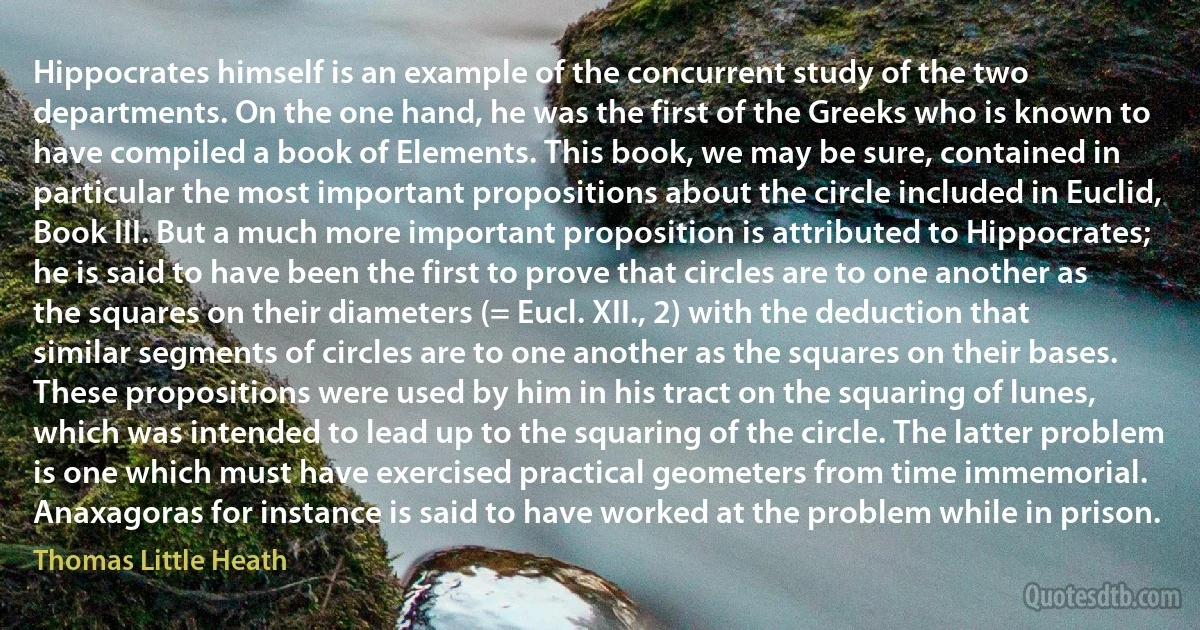
Hippocrates himself is an example of the concurrent study of the two departments. On the one hand, he was the first of the Greeks who is known to have compiled a book of Elements. This book, we may be sure, contained in particular the most important propositions about the circle included in Euclid, Book III. But a much more important proposition is attributed to Hippocrates; he is said to have been the first to prove that circles are to one another as the squares on their diameters (= Eucl. XII., 2) with the deduction that similar segments of circles are to one another as the squares on their bases. These propositions were used by him in his tract on the squaring of lunes, which was intended to lead up to the squaring of the circle. The latter problem is one which must have exercised practical geometers from time immemorial. Anaxagoras for instance is said to have worked at the problem while in prison.
Thomas Little HeathRelated topics
base book concurrent euclid example hand hippocrates instance known lead prison problem prove say squaring study sure time tract while iiiRelated quotes
In his curious tract on Stereometry, published in 1615, Kepler made some advances in the doctrine of infinitesimals. Prompted to the task by a dispute with the seller of some casks of wine, he studied the measurement of solids formed by the revolution of a curve round any line whatever. In solving some of the simplest of these problems, he conceived a circle to be formed of an infinite number of triangles having all their vertices in the centre, and their infinitely small bases in the circumference of the circle, and by thus rendering familiar the idea of quantities infinitely great and infinitely small, he gave an impulse to this branch of mathematics. The failure of Kepler, too, in solving some of the more difficult of the problems which he himself proposed roused the attention of geometers, and seems particularly to have attracted the notice of Cavaleri.

Johannes Kepler
The statement is so frequently made that the differential calculus deals with continuous magnitude, and yet an explanation of this continuity is nowhere given; even the most rigorous expositions of the differential calculus do not base their proofs upon continuity but, with more or less consciousness of the fact, they either appeal to geometric notions or those suggested by geometry, or depend upon theorems which are never established in a purely arithmetic manner. Among these, for example, belongs the above mentioned theorem, and a more careful investigation convinced me that this theorem, or any one equivalent to it, can be regarded in some way as a sufficient basis for infinitesimal analysis. It then only remained to discover its true origin in the elements of arithmetic and thus at the same time to secure a real definition of the essence of continuity. I succeeded Nov. 24, 1858.

Richard Dedekind
With mankind the differences between the sexes are greater than in most species of Quadrumana, but not so great as in some, for instance, the mandrill. Man on an average is considerably taller, heavier, and stronger than woman, with squarer shoulders and more plainly-pronounced muscles. ... Man is more courageous, pugnacious, and energetic than woman, and has a more inventive genius. His brain is absolutely larger, but whether relatively to the larger size of his body, in comparison with that of woman, has not, I believe been fully ascertained. In woman the face is rounder; the jaws and the base of the skull smaller; the outlines of her body rounder, in parts more prominent; and her pelvis is broader than in man; but this latter character may perhaps be considered rather as a primary than a secondary sexual character. She comes to maturity at an earlier age than man.

Charles Darwin
The idea that a few people have about the gene being the target of selection is completely impractical; a gene is never visible to natural selection, and in the genotype, it is always in the context with other genes, and the interaction with those other genes make a particular gene either more favorable or less favorable. In fact, Dobzhanksy, for instance, worked quite a bit on so-called lethal chromosomes which are highly successful in one combination, and lethal in another. Therefore people like Dawkins in England who still think the gene is the target of selection are evidently wrong. In the 30s and 40s, it was widely accepted that genes were the target of selection, because that was the only way they could be made accessible to mathematics, but now we know that it is really the whole genotype of the individual, not the gene. Except for that slight revision, the basic Darwinian theory hasn't changed in the last 50 years.

Ernst Mayr
The theories that I (and others) helped develop explained why unfettered markets often not only do not lead to social justice, but do not even produce efficient outcomes. Interestingly, there has been no intellectual challenge to the refutation of Adam Smith's invisible hand: individuals and firms, in the pursuit of their self-interest, are not necessarily, or in general, led as if by an invisible hand, to economic efficiency. The only question that has been raised concerns the ability of government to remedy the deficiencies of the market. Within academia, a significant fraction of economists are involved with developing and expanding on the ideas of imperfect information (and imperfect markets) that I explored. For instance, Edmund Phelps, this year's Nobel Prize winner, belongs to this "school" of thought. But in political discourse, simplistic "market fundamentalism” continues to exert enormous influence.

Joseph Stiglitz
